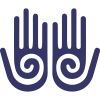Do you think you sit a lot in your day?
Do the maths – do you sit for meals and coffee, do you sit on public transport or in the car or even on a bike? Are you sitting for work and to relax after, to see friends? The chances are high you even sleep on your side in what is pretty much your sitting position. How many hours is that then?
After so much sitting do you feel tension in your body, maybe in the shoulders and the neck? How about the hips and the legs? The back?
Our bodies are not made of parts
Despite the anatomy labels and the pictures in anatomy books that show us how a single muscle might look like, our bodies are one continuous whole. Now you might ask how is this so important. Well, it is important because there is no strict separation between the tissues of the muscles, the nerves, the arteries and veins (and everything else for that matter). They all go together, intertwine, intersect, it’s basically all meshed together in kind of a tidy way.
How muscles affect our nerve and fluid pathways
Yes, that’s right, they contract, they pump, they squeeze. For example, the psoas is the muscle that brings our thighs to our torso. It can get very short and tight with prolonged sitting and it can constrict the flow of blood and nerve signals to our legs. If you are stuck in the area where the blood flows through from the pelvis into the legs, you could have swelling in your ankle, neuropathy, foot drop, tingling, pins and needles, you could have faulty balance.
Then opening the inside of the thigh after prolonged sitting allows the heart to rest. When people are tight in their legs and in their groins, then the heart has to work harder. Via opening up the circulatory flow through the leg, we support ease in the heart and the nourishment of the limb.
Related articles:
Too much sitting – the best posture is the next posture
Photo by Marx Ilagan from Pexels



